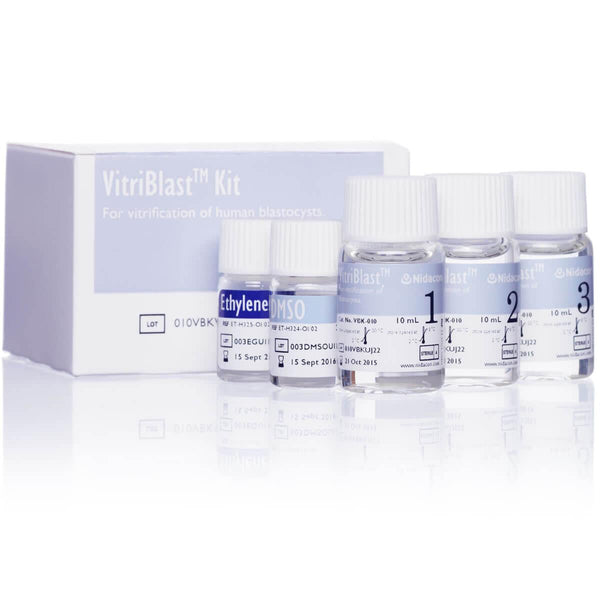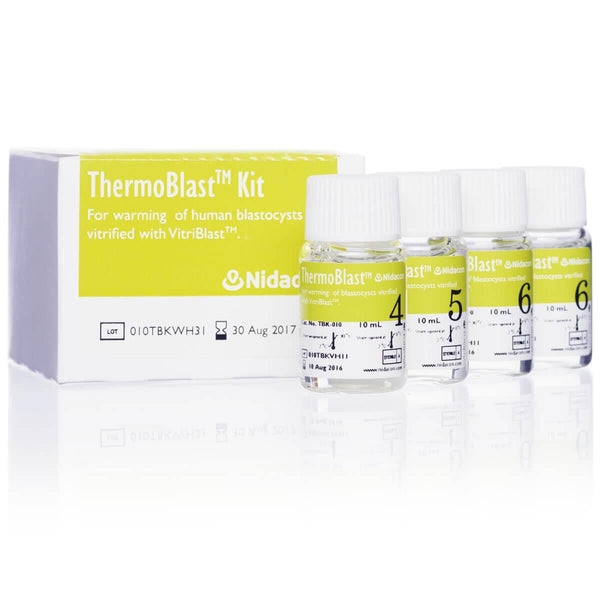
VitriBlast™ & ThermoBlast™
Great results, long shelf life and room temperature storage - all in one kit!
VitriBlast and ThermoBlast are based on clinically, well tested, standard formulations (Lane et al). Numerous publications demonstrate their effectiveness regarding both survival of blastocysts and pregnancy rates. In addition, follow-up studies have been published on live-births, where a comparison is made with new-births from fresh blastocysts, slow-frozen early cleavage stage embryos and vitrified blastocysts (Wikland M et al. (2010).
Components:
- Sodium chloride
- Potassium chloride
- Magnesium sulphate
- Potassium dihydrogen phosphate
- Sodium bicarbonate
- hSA (human Serum Albumin)
- Purified water
- Glucose
- Calcium lactate
- Sodium pyruvate
- EDTA
- HEPES
- Sucrose
- Ethylene glycol
- DMSO
- Ficoll
Performance Characteristics:
- pH: 7.25-7.45.
- Endotoxin levels: <0.5 EU/mL.
- MEA: Re-expanded blastocysts after exposure >80%.
- Bottles and screw caps are M.E.A. tested.
Storage and Stability:
- Store at 35.6°F to 86°F (2 to 30°C) and avoid temperatures above or below these values. Under these conditions VitriBlast has a shelf-life of 12 months. The expiry date is shown on both bottles and cartons.
- Open and close bottles under aseptic conditions. After opening store at 35.6°F to 46.4°F (2 to 8°C) when not in use. Shelf-life on the product label applies when the product is stored according to manufacturer’s recommendations.
- No antibiotics, unstable additives or preservatives have been added by the manufacturer to VitriBlast.
Vitriblast™ & Thermoblast™ Protocol
References:
Prediction of live birth in frozen-thawed single blastocyst transfer cycles by pre-freeze and post-thaw morphology.
Ahlström A1, Westin C, Wikland M, Hardarson T., (2013)
Human Reproduction, Vol.28, No.5 pp. 1199–1209
Vitrification of mouse and human blastocysts using a novel cryoloop container-less technique.
Lane M et al, (1999)
Fertility and Sterility., Vol 72, No 6, pp1073-1078
Vitrification of human blastocysts using cryoloops: Clinical outcome of 223 cycles.
Mukaida T et al. (2003)
Hum Reprod., Vol. 18, No. 2, pp384-391
Perinatal outcome of blastocyst transfer with vitrification using cryoloop: A 4 year follow-up study.
Takahashi K et al. (2005)
Fertil Steril., Vol. 84, No. 1, 88-92
Obstetric outcome of children born after transfer of vitrified blastocysts
Wikland M et al. (2010).
Human Reproduction, Vol.00, No.0 pp. 1–9
Vitrification and warming human blastocysts by use of a laser to artificially induce blastocyst collapse prior to vitrification.
T. Hardarson et al. (2006)
Acta Obstet Gynecol Scand. 86 pp119-120
| VitriBlast | NID-VBK-010 |
| ThermoBlast | NID-TBK-010 |


